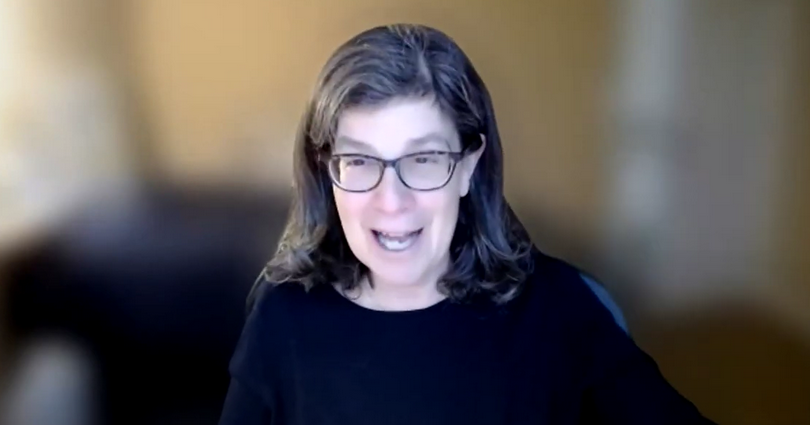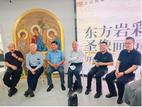On March 24, Rabbi Jan Uhrbach, director of the Block/Kolker Center for Spiritual Arts at the Jewish Theological Seminary (JTS), delivered a lecture titled "Who Shall Cross: A Talmudic Reimagining of the Passover Narrative," analyzing a story from the Talmud—a central text of Rabbinic Judaism containing legal discussions, ethical teachings, and narratives compiled after the Hebrew Bible. Focused on the figure of Rabbi Pinchas ben Yair, a respected Jewish sage from the second century CE, the lecture highlighted how the Talmudic narrative offers new insights into the Exodus story.
Rabbi Uhrbach began by introducing the core Talmudic narrative, which is likely unfamiliar to many outside traditional Jewish study. The story, found in Masekhet Hullin, follows Rabbi Pinchas on a mission to free Jewish captives, reflecting the liberation theme central to Passover. When he reached the River Ginai, he commanded it to divide. The river, personified in the Talmudic narrative, initially refused, arguing that its own God-ordained function (flowing) was a certainty, while Rabbi Pinchas's success in his human mission was uncertain. In response, Rabbi Pinchas declared that if the river did not part, he would decree it to dry up permanently. Consequently, the waters divided for him.
The narrative continues with the river parting again for two others in Rabbi Pinchas's group: One was a fellow Jew carrying wheat specifically to make matzah for Passover, an act defined as a mitzvah (a commandment or religiously significant good deed), directly linking the event to the Exodus observance. The other individual was identified as an Arab merchant, a non-Jew. Rabbi Pinchas instructed the river to part for him as well, explicitly stating the reason: "lest he say, 'Is this how they treat a fellow traveler?'" This action sparked a discussion in the Talmud, with some sages suggesting that Rabbi Pinchas's act placed him on par with Moses, who parted the Red Sea. Ultimately, the Talmud concludes that Rabbi Pinchas was as great as Moses and the generation of the Exodus.
In addition, Rabbi Uhrbach elaborated on the interpretations and contemporary relevance drawn from this narrative. A key theme discussed was the dynamic between the natural world's fulfillment of the divine plan (the river) and human free will. Humans, unlike the river, face uncertainty and the possibility of failure in carrying out God's will, yet the story shows the natural order yielding to the human mission, suggesting the unique value placed on human responsibility and action. This was connected to the meaning of Passover freedom: not just liberation from slavery, but the freedom to undertake purposeful action and service to God, despite inherent challenges.
Furthermore, the lecture paid considerable attention to the inclusion of Arab merchants. Rabbi Uhrbach explained this figure likely represents the Erev Rav, or "mixed multitude," mentioned in Exodus 12:38 – a group of non-Israelites who, according to the biblical text, left Egypt alongside the Israelites under Moses. The Talmudic story's emphasis on ensuring this non-Jewish traveler could also cross was presented as significant. Rabbi Uhrbach suggested this implies an ethical obligation extending beyond one's own community, moving past simple pragmatism toward a principle rooted in divine values. This connects to later Jewish thought, such as the teachings of Maimonides (a major medieval Jewish philosopher and legalist) who argued for caring for non-Jews based on God's universal compassion (citing Psalm 145:9), expanding beyond the concept of acting merely for darkhei shalom ("the ways of peace," or maintaining good relations).
Rabbi Uhrbach also noted a possible linguistic connection between the river's name, Ginai, and the Hebrew word genut ("disgrace" or "shame"). This interpretation suggests that unresolved shame—personal or collective—can act as an obstacle to progress. The concept of confronting shame before redemption was linked to the structure of the Passover Seder, which begins by acknowledging past disgrace before celebrating liberation.
The lecture also compared two versions of the Talmudic story: one from the Jerusalem Talmud, which focuses on ethical treatment of fellow Jews, and another from the Babylonian Talmud, which adds Passover elements and the inclusion of the non-Jewish traveler. Rabbi Uhrbach explained that the Babylonian Talmud likely reshaped the narrative to resonate more with the themes of liberation in the Passover story and broaden the ethical scope to include all people, regardless of origin.
The lecture concluded by positioning these themes— balancing divine will with human agency, extending ethical responsibility universally, and confronting shame for genuine liberation—as profound points drawn from this perhaps unfamiliar Rabbinic narrative, offering rich material for contemplation particularly relevant during the Passover season.












